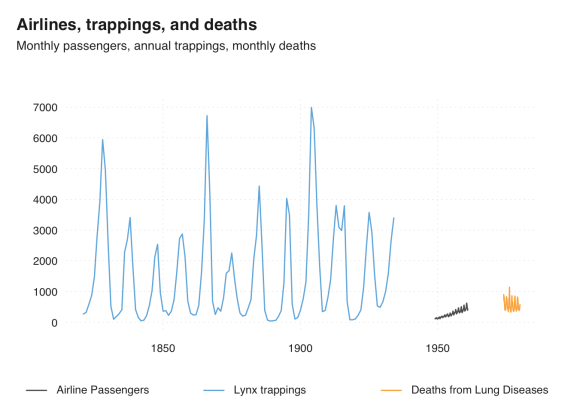tsbox 0.2: supporting additional time series classes
Want to share your content on R-bloggers? click here if you have a blog, or here if you don't.
The tsbox package makes life with time series in R easier. It is built around a set of functions that convert time series of different classes to each other. They are frequency-agnostic, and allow the user to combine time series of multiple non-standard and irregular frequencies. A detailed overview of the package functionality is given in the documentation page (or in a previous blog-post).
Version 0.2 is now on CRAN and provides a larger number of bugfixes. Non-standard column names are now handled correctly, and non-standard column orders are treated consistently.
New Classes
There are two more time series classes supported: tis time series, from the tis package, and irts time series, from the tseries package.
In order to create an object of these classes, it is sufficient to use the appropriate converter.
E.g., for tis time series:
library(tsbox) ts_tis(fdeaths)
## Jan Feb Mar Apr May Jun Jul Aug Sep Oct Nov Dec ## 1974 901 689 827 677 522 406 441 393 387 582 578 666 ## 1975 830 752 785 664 467 438 421 412 343 440 531 771 ## 1976 767 1141 896 532 447 420 376 330 357 445 546 764 ## 1977 862 660 663 643 502 392 411 348 387 385 411 638 ## 1978 796 853 737 546 530 446 431 362 387 430 425 679 ## 1979 821 785 727 612 478 429 405 379 393 411 487 574 ## class: tis
Or for irts time series:
head(ts_irts(fdeaths))
## 1974-01-01 00:00:00 GMT 901 ## 1974-02-01 00:00:00 GMT 689
Conversion works from all classes to all classes, and we can easily convert these objects to any other time series class, or to a data frame:
x.tis <- ts_tis(fdeaths) head(ts_df(x.tis))
## time value ## 1 1974-01-01 901 ## 2 1974-02-01 689 ## 3 1974-03-01 827 ## 4 1974-04-01 677 ## 5 1974-05-01 522 ## 6 1974-06-01 406
Class-agnostic functions
Because coercion works reliably and is well tested, we can use it to make functions class-agnostic. If a class-agnostic function works for one class, it works for all:
ts_pc(ts_tis(fdeaths)) ts_pc(ts_irts(fdeaths)) ts_pc(ts_df(fdeaths)) ts_pc(fdeaths)
ts_pc calculates percentage change rates towards the previous period. It works like a ‘generic’ function: You can apply it on any time series object, and it will return an object of the same class as its input.
So, whether we want to smooth, scale, differentiate, chain-link, forecast, regularize or seasonally adjust a series, we can use the same commands to all time series classes. tsbox offers a comprehensive toolkit for the basics of time series manipulation. Here are some additional examples:
ts_pcy(fdeaths) # pc., comp. to same period of prev. year ts_forecast(fdeaths) # forecast, by exponential smoothing ts_seas(fdeaths) # seasonal adjustment, by X-13 ts_frequency(fdeaths, "year") # convert to annual frequency ts_span(fdeaths, "-1 year") # limit time span to final year
There are many more. Because they all start with ts_, you can use auto-complete to see what’s around. Most conveniently, there is a time series plot function that works for all classes and frequencies:
ts_plot( `Airline Passengers` = AirPassengers, `Lynx trappings` = ts_tis(lynx), `Deaths from Lung Diseases` = ts_xts(fdeaths), title = "Airlines, trappings, and deaths", subtitle = "Monthly passengers, annual trappings, monthly deaths" )

R-bloggers.com offers daily e-mail updates about R news and tutorials about learning R and many other topics. Click here if you're looking to post or find an R/data-science job.
Want to share your content on R-bloggers? click here if you have a blog, or here if you don't.
